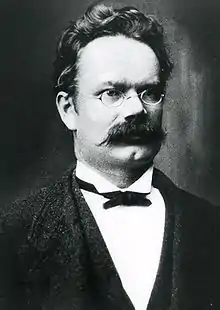Curt Wachsmuth | |
|---|---|
 Curt Wachsmuth (1884) | |
| Born | 27 April 1837 |
| Died | 8 June 1905 (aged 68) |
| Nationality | German |
| Education | University of Jena University of Bonn |
| Occupation(s) | historian and classical philologist |
| Known for | professor at Universities of Göttingen, Heidelberg, Leipzig |
| Notable work | Anthologium |
| Relatives | Friedrich Ritschl (father-in-law) |
Curt Wachsmuth (27 April 1837, Naumburg an der Saale – 8 June 1905, Leipzig) was a German historian and classical philologist. He was a son-in-law to philologist Friedrich Ritschl.
Academic biography
From 1856 to 1860 he studied at the universities of Jena and Bonn, where he later received his habilitation in classical philology and ancient history. In 1864 he became a professor in ancient history at the University of Marburg, followed by professorships in classical philology at the universities of Göttingen (1869–1877) and Heidelberg (1877–1885). From 1885 to 1905 he was a professor of classical philology and ancient history at the University of Leipzig. In 1897/98 he served as university rector.[1]
Published works
Among his better written efforts were a two volume work on ancient Athens (1874, 1890), an introduction to the study of ancient history (1895) and with Otto Hense, a five volume edition of Stobaeus' Anthologium.[2]
- De Cratete Mallota disputavit adiectis eius reliquiis, Leipzig 1860 (S. 1-36 appeared as dissertation)
- Die Stadt Athen im Altertum, 2 volumes, Leipzig 1874, 1890 – The city of Athens in antiquity
- Studien zu den griechischen Florilegien, 1882 – Studies of Greek florilegia
- Ioannis Stobaei Anthologium (with Otto Hense), 5 volumes. 1884–1912 – edition of Stobaeus
- Sillographorum Graecorum reliquiae. Praecedit commentatio de Timone Phliasio ceterisque sillographis, Leipzig 1885
- Neue Beiträge zur Topographie von Athen, 1887 – New contributions on the topography of Athens
- Einleitung in das Studium der alten Geschichte, Leipzig 1895 – Introduction to the study of ancient history
- Ioannis Laurentii Lydi Liber de Ostentis et Calendaria graeca omnia, 1897 – edition of John the Lydian[3][4][1]
References
- 1 2 Professorenkatalog der Universität Leipzig Biographical sketch
- ↑ The eithteenth century in Germany, and the nineteenth century in Europe by John Edwin Sandys.
- ↑ Most widely held works by Curt Wachsmuth OCLC WorldCat Identities
- ↑ IDREF.fr bibliography